The Dentition of Hemipristis elongata (KLUNZINGER, 1871)
Material: age: immature (?); sex: ?; Total Length: 130 - 150 cm (?)
Preperation of teeth:
- one site of the jaw was soaking in water for three days
- extracting the teeth from the jaw
- bleaching in laundry bleach for 4 - 6 hours
- cleaning with brush
- making picture with Wild Heerbrugg Binocular M3Z with LEICA IC80 HD digital camera
- measuring with software LEICA Application Suite (LAS EZ)
- image editing with software Gimp vers. 2.6
Comparison between the speciemen described in Bass et al. (1975), Smith (1957) and Baranes et al. (1979) and the jaw of this study:
| Tooth Nr. | 5 | Bass (1975) |
Smith (1957) |
Baranes (1979) |
| W = Width in mm | 6,93 | 6,20 | 6,90 | 8,50 |
| LD = Length diagonal in mm | 11,89 | 11,60 | 12,80 | 15,10 |
| L = Length in mm | 7,73 | 7,80 | 7,80 | 11,70 |
| Remarks | TL 137 cm, female | TL 136,5 cm, female | TL 196 cm, female |
Upper Jaw - lingual (Click on the tooth, for a large image)
Upper Jaw - labial (Click on the tooth, for a large image)
Measurement:
| Tooth Nr. | 1 | 2 | 3 | 4 | 5 | 6 | 7 | 8 | 9 | 10 | 11 | 12 | 13 |
| W = Width in mm | 1,48 | 3,01 | 5,07 | 6,94 | 6,93 | 7,27 | 7,09 | 7,85 | 6,13 | 5,36 | 4,41 | 3,02 | 2,27 |
| LD = Length diagonal in mm | 4,46 | 9,96 | 10,65 | 9,47 | 11,89 | 12,64 | 11,88 | 10,96 | 10,27 | 8,42 | 6,91 | 4,81 | 3,05 |
| L = Length in mm | 4,37 | 9,13 | 8,17 | 5,55 | 7,73 | 8,00 | 6,99 | 6,54 | 5,72 | 4,56 | 3,37 | 2,43 | 1,47 |
| Remarks | broken | broken |
Lower Jaw - labial (Click on the tooth, for a large image)
Lower Jaw - lingual (Click on the tooth, for a large image)
Measurement:
| Tooth Nr. | 1 | 2 | 3 | 4 | 5 | 6 | 7 | 8 | 9 | 10 | 11 | 12 | 13 | 14 | 15 |
| W = Width in mm | 1,23 | 1,58 | 2,51 | 2,61 | 2,75 | 2,79 | 2,91 | 2,87 | 3,05 | 3,20 | 3,41 | 3,44 | 2,91 | 1,77 | 1,01 |
| LD = Length diagonal in mm | 8,22 | 9,35 | 9,78 | 9,16 | 9,63 | 6,24 | 6,50 | 6,87 | 6,31 | 6,20 | 5,86 | 5,11 | 4,05 | 2,60 | 1,53 |
| L = Length in mm | 8,19 | 9,16 | 9,72 | 9,07 | 9,39 | 5,78 | 6,02 | 6,36 | 5,78 | 5,49 | 4,53 | 3,44 | 2,30 | 1,44 | 1,02 |
| Remarks | broken | broken |
Root description:
a) upper jaw (tooth Nr. 2/7)
Systematic and abbreviations after Compagno (1988)
Description: root with an basal groove, upper teeth with one or two central foramina and several mesial and distal lingual foramina
a) lower jaw (tooth Nr. 2/8)
Systematic and abbreviations after Compagno (1988)
Description: root with an basal groove, teeth with one or two central foramina and several mesial and distal lingual foramina
Tooth disease/demage (upper jaw, tooth nr. 2, labial)
Images Jaw
Tooth descriptions:
- Baranes et al. (1979):
..."The teeth of Hemipristis elongatus are characteristic for the genus. Leriche (1938) and Smith (1957) give a good description of the dentition of the species. The base of each tooth is deeply indented and appears double; based on this character Klunzinger (1871) named the genus Dirrhizodon. In neither jaw is there a median tooth but the 2 halves of the jaws are clearly separated by a groove. The front teeth of the upper and lower jaws are of different shape (Figs. 5 & 6).
The first 2 teeth from the symphysis of the upper jaw are straight. From the 3rd they are oblique, pointing towards the corner of the mouth. The tooth nearest the symphysis has only 2 cusps near its base. The inner margin of the 2nd tooth is serrated. All the teeth from the 3rd to the 14th have both margins serrated.
The front teeth of the lower jaw are slender, several series are erect and somewhat recurved. The 4th and 5th teeth are highest. The first 7 teeth have 2 basal cusps and no serrations; from the 8th. all teeth haw the inner margin serrated. From the 11th onward, the teeth are obliquely inclined towards the corner of the mouth and resemble the upper jaw teeth. Dental formula of the 1960 mm specimen, counted in situ is 14-14/17-17; a count from the X-ray of the head gives the exact formula 14-14/18-18 and 14-14/18-18 obtained from the X-ray of the head of the 1856 mm specimen, which agrees with Smith's (Basset al. 1975) and Setna and Saranngdhar's (1949) counts. Fourmanoir (1961) reported 14-14/17-17 for the 3 specimens and Gohar and Mazhar (1964) noted 28 (14 14)/34 (17-17) for the 2 specimens."... - Bass et al. (1975):
..."The teeth of the 137 cm female from Zanzibar described by J. L. B. Smith (1957d) are illustrated in pl. 5. Smith gives the dental formula of this shark as13-13/16-16 but a recount of the left side of the same jaw gives a count of 14/18. The shark taken on the Natal coast had a tooth count of 14-14/18-18 . Fourmanoir (1961) notes a count of 14-14/17-17 in specimens from Madagascar and Setna and Sarangdhar (1949) recorded counts of 13 or 14-13 or 14/18-18 in sharks from India." - Compagno (1984):
a) Description genus: ..."Description genus: ...lower jaw truncated at symphysis; ends of upper labial furrows behind rear corners of eyes; a toothless space at midlines of both jaws; upper anterolateral teeth with serrated (smooth in young) mesial edges and short cusps; lower anterolateral teeth with very long, stout, strongly hooked cusps, and serrations and cusplets variably developed an the crown feet; lower crown feet and roots deeply arched, giving teeth an inverted Y shape; lower teeth protrude prominently when mouth is closed; tooth row counts 26 to 30/30 to 36, with 4 to 9 more lower rows than uppers."
b) Description species: ..."mouth with truncated lower symphysis and prominently protruding lower teeth, upper teeth with distal cusplets and mesial serrations, lower teeth with extremely long, hooked cusps and cusplets and serrations at their bases, ..." - Compagno (1988)
..."Tooth groups present include symphysials, symphysialized medials, anteriors, laterals, and poorly differentiated posteriors in both jaws. The medials are very small, clawlike teeth with very narrow roots and strongly hooked cusps; symphysials are similar but larger, with broader asymmetrical roots. Upper anteriors are abruptly larger, broader, and flatter than the symphysials and differ from the laterals in having much narrower roots and crowns. The lower anteriors are very high, narrow, deep-rooted and hook-cusped teeth having serrations or cusplets, if any, confined to the crown foot, and form a spike-studded impaling pad resembling those of Chaenogaleus, Isurus, Odon-t asp is, Eugomphodus, Mitsukurina, and Pseudocar-charias. The lower anteriors grade into the laterals by becoming lower- crowned, flatter, broader, shorter-cusped, and by having serrations or fine cusplets extending onto the distal crown feet. Upper laterals are very broad, wide, triangular teeth, with compressed, horizontal-edged roots, broadly convex mesial edges, and arcuate distal edges having coarse serrations or cusplets. In small specimens the cusps of all teeth are slightly more oblique than those of adults and subadults. In the young a few distal cusplets are present on upper laterals (five on fifth upper laterals of a 532 mm. specimen) but these become more numerous on adults and subadults (ten or more on fifth upper lateral) and turn into coarse serrations. The upper laterals of young H. elongatus more closely resemble those of the hemigaleine genera than do those of adults and subadults. Tooth rows 26-30/30-36 (Setna and Sarangdhar, 1949b, Four-manoir, 1961, Bass et al., 1975b, and ten specimens counted here). Lower teeth in 4-9 more rows than uppers. Tooth series functional about 1—3/ 2-4. Tooth formula M l/1, S 1/1, A 0-2/ca. 3-6, L 8-10/ca. 6-10 (or /AL 11-14), P 1-2/2-3; or AP 12-14/14-17. Lower teeth strongly protruding from mouth when mouth is closed..." - Chandler et al (2006):
a) ... "Baranes and Ben-Tuvia (1979) give a typical dental formula for the extant species as but without identifying the numbers of anterior, lateral, and posterior teeth. On one side of the upper jaw there are two reduced-size teeth adjacent to the midline which are designated as parasymphyseals, followed by two full-sized teeth designated as anteriors, followed by six to seven laterals, and ending with three to four posteriors. The lateral teeth are all rather similar, and it is difficult to assign a precise jaw position to fossil lateral teeth...."
b) “IMMATURE OR ADULT: …This study attempts to identify a phyletic change in teeth of Hemipristis serra, which is almost certainly an ontogenic change as well. Thus, care must be taken to limit the use of juvenile specimens because they might express the earlier pattern. Compagno (1988, pp. 269-270) has observed that in teeth of young Hemipristis elongata (the extant species, see Figure 4): “…a few distal CUSPLETS are present on upper laterals (five on fifth upper laterals of a 532 mm. specimen) but these become more numerous on adults and subadults (ten or more on fifth upper lateral) and turn into coarse serrations.” Assuming the teeth of all Hemipristis species behaved similarly, Compagno’s (1988) description provides a means for distinguishing immature teeth. Typical features include small size, a few large distal “cusplets” (serrations), reduced or no mesial serrations, and a long unserrated tip….” - Fourmanoir, P. (1961):
..."La formule dentaire est 14 - 0 -14/17 - 0 - 17, il y a en effet un net intervalle sans dents à la symphyse (fig. 37).
Les dents sont fortement dissemblables. A la mâchoire supérieure, à l'exception de deux rangées de dents allongées et droites près de la symphyse, les dents sont incurvées et fortement denticulées des deux côtés. A la mâchoire inférieure, les dents antérieures sont constituées d'une longue cuspide fortement recourbée près de la symphyse, pourvues ou non d'une petite cuspide de chaque côté de la base étroite, latéralement les dents s'élargissant en triangle incurvé vers l'arrière avec le bord postérieur concave fortement denticulé (fig. 38)...." - Herman, J. & Hovestadt-Euler, M. & Hovestadt, D.C. (2003):
..."The root shows a relatively fine, reticulated system of relatively fine, enlarged osteons. From this system, a narrow, enlarged central canal runs toward the apex of the crown. From this canal, an irregularly reticulated system of narrow osteons radiates randomly into the crown. Besides a small band of rudimentary circumpulpar dentine at the crown margins, the crown is filled with osteodentine..." - Klunzinger, C.B. (1871):
Gattung: Dirrhizodon:
…"Die Zähne sind dreieckig, ohne Basalabsatz, etwas nach hinten geneigt oder gekrümmt. Die Ränder sind gesägt, der Spitzentheil ganzrandig. Die Zahnwurzel an ihrer Basis tief gebuchtet und dadurch wie doppelt. Die Zähne des Oberkiefers sind grösser, platter und breiter, die des Unterkiefers sind, wenigstens die vorderen, sehr schlank, fast ungezähnt, nur mit einigen Zähnchen an der Basis versehen. Ihre Fläche ist rück- respective einwärts gekrümmt. Nach hinten werden diese Zähne breiter, mehr denen des Oberkiefers ähnlich, während wiederum auch die vordersten Zähne des Oberkiefers schlanker und denen des Unterkiefers ähnlicher werden. Kein Mittelzahn, die Mittellinie beider Kiefer ist vielmehr zahnlos"….
Dirrhizodon elongatus Klz.
…"In jedem Kiefer 13/13 Zähne in einer Reihe und meist je 6 Reihen von aussen nach innen"…. - Leriche, M. (1938)
... "La denture d'Hemipristis elongatus.
Des différences très nettes séparent les dents des deux mâchoires (fig. 3 et 4 dans le texte). Si l'on excepte les dents symphysaires, les dents de la mâchoire supérieure sont plus grandes, plus larges et plus comprimées que les dents correspondantes de la mâchoire inférieure. De plus, dans toutes les dents de la mâchoire supérieure, y compris les dents symphysaires, les bords de la couronne sont denticulés sur une plus grande longueur; dans la plupart des dents, ils ne deviennent lisses qu'au voisinage de la pointe de la couronne.
Mâchoire supérieure (fig. 3 dans le texte). — Il y a, à chaque demi-mâchoire, deux files de dents symphysaires petites, quoique d'inégale grandeur: celles de la première file (SI) sont très petites; celles de la seconde file (SII) sont beaucoup plus grandes, mais leurs dimensions restent de beaucoup inférieures à celles des files suivantes. Toutes les dents symphysaires sont légèrement comprimées, et leurs bords ne portent qu'un petit nombre de denticules: un denticule très petit et acéré, à la base du bord antérieur, et, au bord postérieur, 2 ou 3 denticules espacés, dans les dents de la première file, 5 à 7 denticules plus serrés, dans celles de la seconde file.
Les autres dents sont disposées en 12 files. Elles sont beaucoup plus grandes et plus comprimées, d’autant plus comprimées qu'elles appartiennent à des files plus postérieures.
L’appelle dents antérieures, les dents des deux premières files (Ai, An); dents latérales, cellesdes dix files suivantes (Li à Lx).
Les dents antérieures, surtout celles de la première file, sont relativement étroites, et leur couronne est modérément inclinée du côté postérieur. Les branches de leur racine sont fort rapprochées, seulement un peu divergentes dans les dents de la seconde file.
Les dimensions des dents de la première file sont sensiblement plus petites que celles des dents la seconde file.
Les dents latérales sont très comprimées et plus larges, relativement d'autant plus larges qu’elles appartiennent à des files plus postérieures. Leur couronne se recourbe de plus en plus vers l’arrière; le bord antérieur devient de plus en plus convexe, tandis que le bord postérieur reste modérément concave.
Les denticules sont inégalement développés sur les deux bords; ceux du bord postérieur sont sensiblement plus grands que ceux du bord opposé. A mesure que les dents deviennent plus postérieures, la partie denticulée des bords s'allonge vers la pointe de la couronne, et, dans les dents latérales les plus postérieures, la pointe n'apparaît plus guère que comme un denticule terminal plus fort que les autres.
Enfin, les branches de la racine sont très divergentes.
Les dents des files latérales antérieures sont les plus grandes de toute la mâchoire. A partir de la 7e file, la hauteur des dents décroît progressivement jusqu'à la dernière file.
Dans les dents des dernières files, la couronne est fortement couchée sur la racine, et sa base se prolonge, du côté postérieur, en un talon denticulé; de sorte que ces dents rappellent celles des Galeus et des Galeocerdo.
Mâchoire inférieure (fig. 4 dans le texte). — La symphyse est très longue, et la région symphysaire porte, à chaque demi-mâchoire, trois files de petites dents élancées (S I, S II, S III) analogues aux dents symphysaires de la mâchoire supérieure, mais plus épaisses et moins comprimées. Les bords de la couronne cessent d'être tranchants à la base, et ne sont pas denticulés. Ce n'est que dans quelques rares dents que l'on observe, à la base de la couronne, une paire de denticules extrêmement petits et acérés.
Les dimensions des éléments qui composent les files symphysaires augmentent de la lre file à la 3e: les dents de la lre file sont très petites et très étroites; celles de la 2e sont déjà beaucoup plus grandes; celles de la 3e sont plus grandes encore.
Les dents des quatre files suivantes (A I à A IV), que je qualifie d'antérieures, occupent avec les dents symphysaires la partie antérieure de chaque demi-mâchoire. Elles se distinguent encore par leur forme élancée, mais leurs dimensions sont beaucoup plus grandes que celles des dents symphysaires. Leur couronne s'élève verticalement, tout en décrivant une courbure sigmoïdale; les denticules sont peu nombreux. Les branches de la racine sont distinctes, mais fort rapprochées.
Des différences assez sensibles apparaissent entre les dents de la première file antérieure et celles de la quatrième.
Dans les premières, la couronne est étroite et épaisse; ses bords cessent d'être tranchants à la base; il n'y a qu'une paire de denticules très petits et acérés; les branches de la racine ne sont pas encore nettement individualisées. Ces dents ressemblent encore beaucoup aux dents symphysaires.
Dans les éléments de la quatrième file antérieure, la couronne est légèrement plus large; ses bords sont tranchants sur toute leur longueur; il y a, au bord postérieur, 1 ou 2 denticules, au bord antérieur, 3 ou 4, irrégulièrement espacés; enfin, les branches de la racine sont bien distinctes mais faiblement divergentes.
Les dents des 2e et 3e files établissent la transition entre celles des lre et 4e files.
La partie latérale de chaque demi-mâchoire est garnie de onze files de dents (L I à L XI), dont la couronne est inclinée vers l'arrière, — faiblement dans la lre file latérale, de plus en plus dans les files suivantes, — et dont les branches de la racine vont en divergeant de plus en plus, de la première à la dernière file.
Les denticules sont encore peu nombreux dans les dents de la lre file latérale: 2 ou 3 au bord postérieur, 4 ou 5 au bord antérieur. Puis leur nombre augmente rapidement dans les files suivantes; ils deviennent plus serrés et, à partir de la 3e file, nettement plus forts au bord postérieur qu'au bord antérieur. La partie denticulée des bords ne dépasse que faiblement — si ce n'est dans les files les plus postérieures — la mi-hauteur de la couronne.
Les dents de la première file latérale sont, avec les dents antérieures, les plus grandes de la mâchoire inférieure. A partir de la 2e file latérale, la hauteur de la couronne décroît régulièrement jusqu'à la dernière file. Les dents latérales sont ainsi relativement d'autant plus larges qu'elles sont plus postérieures.
Les dents latérales les plus postérieures, comme les dents correspondantes de la mâchoire supérieure, rappellent les dents des Gale us et des Galeocerdo.
D'après la description qui vient d'être faite de la denture d'Hemipristis elongatus, la formule dentaire de cette espèce est donc:
Mâch. supér.: 2 Ds1) + 2 Da + 10 DI
Mâch. infér.: 3 Ds + 4 Da + 11 Dl
Ds, Da, Dl sont les abréviations respectives de files de Dents symphysaires, de Dents antérieures et de Dents latérales...."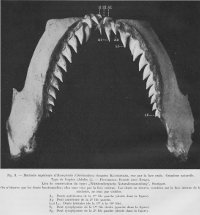
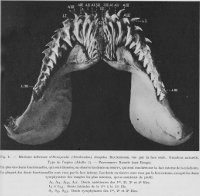
- Smith, J.L.B. (1957)
..."The roots of most of the teeth are incised in the midline (see fig. 1, 10, above), but not markedly more so than is observed in some species of Carcharhinus Blainville, 1816. In neither jaw is there any median tooth, the teeth on each side are clearly divided by a median naked groove. On each side of this in the upper jaw are three long, smooth, erect recurved awl shaped fangs—the most anterior is well separated from its fellow, the second is somewhat behind and set almost on the edge of the median groove, almost touching its fellow, the third, hindmost, is set well back, and this pair is the most widely separated. On each side of the base of each fang is a small rudimentary cusp-like process. Lateral to and opposite the second fang is an acutely triangular compressed tooth, the inner edge smooth, the outer edge with five serrae, the apical half entire. Outside this, on the front of the jaw is a similar tooth, with two serrae on the inner and eight on the outer, the apical two fifths with entire edges. Behind this latter is a similar tooth, retrose, bent slightly outwards.
Lateral to the second front tooth, on the outside of the jaw, is a compressed subtriangular tooth curved outwards, with nine serrae on the outer and eight on the inner edge. The remaining teeth on the side of the upper jaw are mainly in a single erect series and postenorly become gradually smaller, more recurved, those at the hind end of the jaw resembling in shape the corresponding teeth in the lower jaw; most have only the apical fourth with entire edge, the serrae on the inner margin in general smaller and more numerous than those on the outer (see fig. 1) The hindmost one or two teeth in the upper jaw have no serrae on the inner margin. There are 12 to 13 teeth in the outer series on each side of the upper jaw.
In the lower jaw all teeth in front long and slender, awl-shaped several series erect, somewhat recurved, forming an irregular symphyseal cluster of 15 to 16 teeth on each side, the two clearly separated by a deep groove. Four or five of the front median teeth on each side are strongly antrorse and exsert. The symphyseal cluster on each side consists of four ill defined irregular oblique rows, each row running inwards and back, but the setting is not symmetrical, nor exactly alike on both sides. On the left dose to the median inwardly directed lappet of skin is a smooth slender antrorsley recurved fang (fig. 1, A & C, No. 2), with a small basal denticle on one side. Inwards and back are three more similar but progressively smaller teeth, two close together near the mid-line, all these without basal denticles. The next tooth outwards in the front series (fig. 1, A & C, No. 3) is the first of a similar oblique row of four (five on the other side) running in back. The front tooth of this series is elongate, awl shaped (but slight y wider than the first tooth near symphysis), its edges distinct, and with a small basal denticle on each side. Inwards and back in this row to near the midline are three similar teeth, the second and third subequal with the first tooth in front, each with a small basal denticle each side. The fourth tooth behind in this row has only minute basal denticles. Behind it is a similar almost concealed tooth, not erect. (The fifth tooth on the other side, set near the edge of the median groove is smaller, strongly recurved, longitudinally compressed at the base and without basal denticles).
The third oblique row from the symphysis consists of four similar teeth, the first three subequal, fang-like, the first two antrorse, the third erect, the fourth and fifth retrorse, each with a small basal denticle each side. Outside this third oblique row is a fourth similar row of three teeth, the anterior (fig. 1, A & C, No. 5) smallest, the inner two graduated larger, all with entire edges, each with one inner and outer basal denticle. Within and behind these symphyseal clusters are numerous concealed retrorse successive similar fang-like teeth, medially in 8 to 9 series, graduated fewer outwards (Plate XVII, B). The remaining teeth in the side of the jaw are in two erect series, the inner slightly the larger, but all become distally at first slightly broader (triangular), then shorter and curved outwards (back), the inner edges all smooth, increasingly more of the outer edge with large serrae. The hindmost teeth are small and curved backwards, the main cusp almost horizontal. There are sixteen teeth in all in the outermost series on each side of the lower jaw (see fig. 1)...."
References:
BARANES, A. & BEN-TUVIA, A. (1979)
Two rare carcharhinids, Hemipristis elongatus and Iago omanensis, from the northern Red Sea. Israel Journal of Zoology, 28 (1): 39-50
BASS, A.J. & D'AUBREY, J.D. & KISTNASAMY, N. (1975)
Sharks of the east coast of Southern Africa. III. The families Carcharhinidae (excluding Mustelus and Carcharhinus) and Sphyrnidae. Investigational Report Oceanographic Research Institute, 38: 1-100
CHANDLER, R.E. & CHISWELL, K.E. & FAULKNER, G.D. (2006)
Quantifying a Possible Miocene Phyletic Change in Hemipristis (Chondrichthyes) Teeth. Palaeontologia Electronica, 9 (1): 4A:14p
COMPAGNO, L.J.V. (1984)
FAO Species Catalogue. Vol 4: Sharks of the world, Part 2 - Carcharhiniformes. FAO Fisheries Synopsis No. 125, 4 (2): 251-633
COMPAGNO, L.J.V. (1988)
Sharks of the order Carcharhiniformes. Princeton University Press, New Jersey 1988
KLUNZINGER, C.B. (1871)
Synopsis der Fische des Rothen Meeres II. Theil. Verhandlungen der Königlischen Zoologischen-Botanischen Gesellschaft in Wien, 21: 441-688.
HERMAN, J. & HOVESTADT-EULER, M. & HOVESTADT, D.C. (2003):
Contributions to the study of the comparative morphology of teeth and other relevant ichthyodorulites in living supraspecific taxa of chondrichthyan fishes. Part A: Selachii. Addendum to 1: Order Hexanchiformes-Family Hexachidae, 2: Order Carcharhiniformes, 2a: Family Triakidae, 2b: Family Scyliorhinidae, 2c: Family Carcharhinidae, Hemigaleidae, Leptochariidae, Sphyrnidae, Proscylliidae and Pseudotriakidae, 3: Order Squaliformes: Family Echinorhinidae, Oxynotidae and Squalidae. Tooth vascularization and phylogenetic interpretation. Bulletin de l´Institut Royal des Sciences naturelles de Belgique, Biologie, 73: 5-26
FOURMANOIR, P. (1961):
Requins de la cote ouest de Madagascar. Mémoires de l'Institut Scientifique de Madagascar. Série F. Océanographie, 4: 1-81, Pls. 1-18
LERICHE, M. (1938):
Contribution à l'étude des poissons fossiles des pays riverains de la Méditerranée américaine (Venezuela, Trinité, Antilles, Mexique). Mémoires de la Société Paléontologique Suisse, 61 (1): 42 p., 5 fig., 4 pl.
SMITH, J.L.B. (1957)
The rare shark Hemipristis elongatus (Klunzinger), 1871, from Zanzibar and Mozambique. Annals and Magazine of Natural History, (Series 12), 10: 555-560










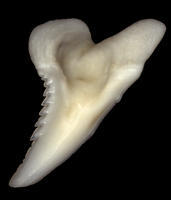
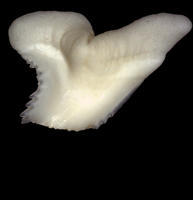
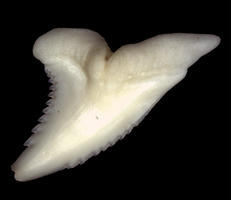
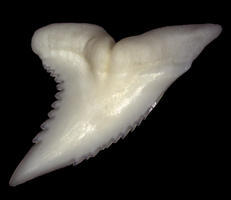
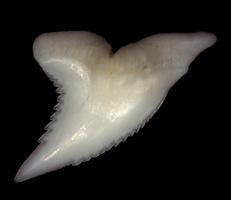
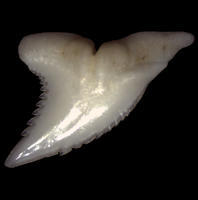

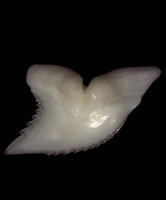
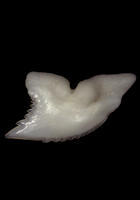
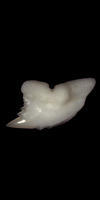


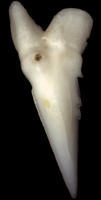
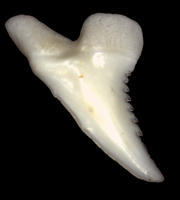
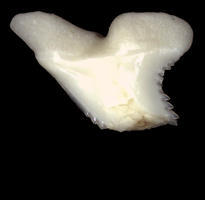

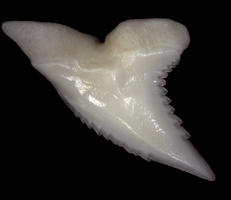
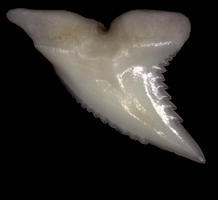
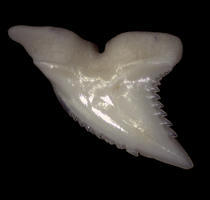
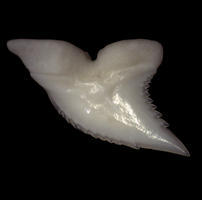
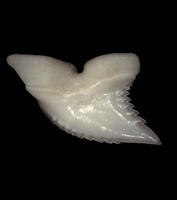
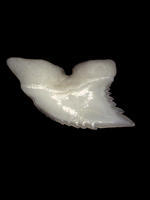
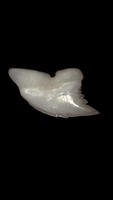

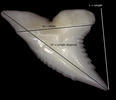
































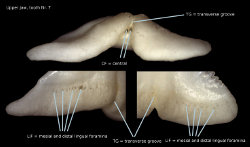
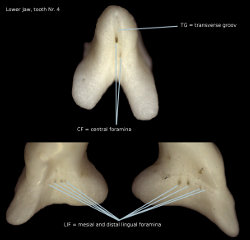
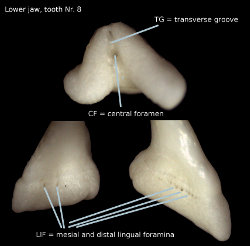
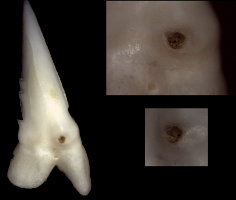
_th.JPG)
(1)_th.jpg)
(2)_th.jpg)
(3)_th.jpg)
(4)_th.jpg)
(5)_th.jpg)








